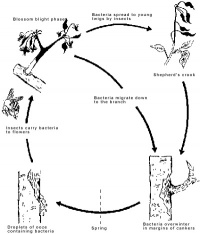There are no products in your shopping cart.
Questions & Answers
Fireblight
Question
I think my quince tree had fire blight. The leaves went a dapplesd brown with curled up edges, but they did not fall off the tree. At the very top of the tree seemed a perfectly happy new shoot. On reccomendation I took off all the branches and leaves and burned them. The main bough is still in the ground awaiting felling.To the right of the tree is a lacecap hydrangea who's leaves are turning red and it is not flowering as well as usual. Do you think it has anything to do with the diseased tree. If so how far would the disease spread in the soil to the rest of my garden, which is full of shrubs and trees? Is it possible to test the surrounding soil to see if it is toxic? I have a large mature garden that has taken years to reach the beautiful stage is now at. Please help with some ideas. Regards Irene Rogers
Answer
Irene,
Fire blight is bacterial disease which only affects certain species of plants in the rose family (Rosaceae) and will not have an affect on your hydrangea. Symptoms of fire blight include dead branches, water-soaked blossoms, light brown to blackened leaves, discolored bark, black “shepherd’s crook” twigs, and dried fruits, does this describe the symptoms your Quince tree exhibited?
You can have your soil tested however fire blight is not a soil borne pathogen and will most likely not show up in the test. Fire blight is most commonly spread by flying insects, splashing water and infected pruning tools. When pruning an infected tree it is important to sanitize your tools between each cut by dipping the pruning blades in bleach, alcohol or spraying with a household sanitizer.
It's hard to say what is causing your hydrangea to turn red. High humidity and little air flow could be causing Rust (Pucciniastrum hydrangae) a fungus that survives on living tissue. Rust appears as brown to orange powdery pustules and yellow spots on leaves and may cause leaves to drop prematurely. As for the lack of flowers there are three main reasons hydrangea will have few or no blooms; not enough sunlight, improper pruning and bud damage (Hail, wind, mechanical).
There are university extensions and private companies that can test soil however it can be expensive and take many weeks for the results. There is no single test that can test soil for everything so they most likely will only test for particular pathogens.
I would recommend removing the Quince tree from your garden completely and replacing it with either a blight resistant cultivar or a different tree or shrub species all together. If you disposed of the infected debris properly the fire blight is most likely an isolated incident, keep an eye on your hydrangea and any other species of the rose family you may have in your garden.
Plants from the Rosaceae family known to be affected by fire bight include; apples (Malus spp.), pears (Pyrus spp.), and crabapples (Malus spp.). The disease also can occur on serviceberries (Amelanchier spp.), flowering quinces (Chaenolmeles spp.), cotoneasters (Cotoneaster spp.), hawthorns (Crataegus spp.), quinces (Cydonia spp.), pyracanthas (Pyracantha spp.), blackberries (Rubus spp.), raspberries (Rubus spp.), and mountain ashes (Sorbus spp.).
Hope this answers your question, Happy Gardening!
Plant Life Online
Fire Blight life cycle image is from Colorado Sate University Extension.
- Login to post comments
Ask a Question
Please enter your question and include your locale or zone. The answers to your questions will be posted under Q&A for you and your fellow gardeners see. Check back soon!
Recommeded Products
On Sale
Soji Pod Lanterns
$15.95Mini Herb Pail
$12.99Okatsune Pruners 7"
$32.95






